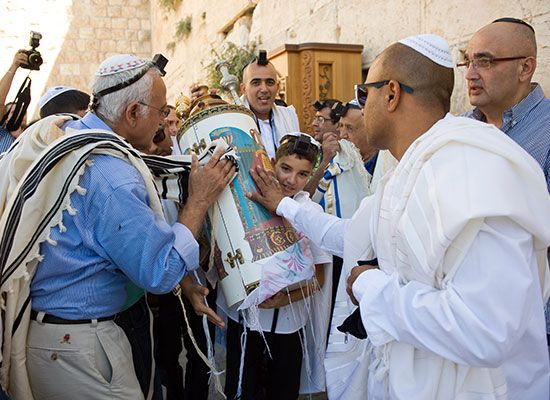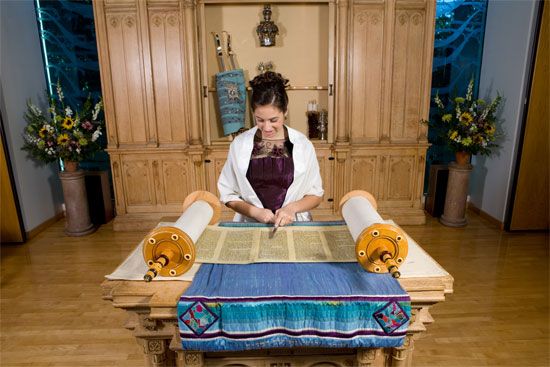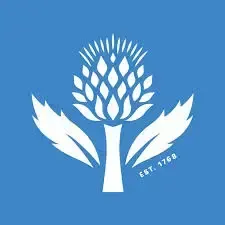bar and bat mitzvah
- Hebrew:
- “son and daughter of the commandment”
- Also spelled:
- bar mitzva or mitzwa
- Plural:
- bar or bat mitzvahs, bar or bat mitzvot, b’nai mitzvot, or b’not mitzvah
What is a bar or bat mitzvah?
What is the significance of a bar or bat mitzvah?
What are some components of a typical bar or bat mitzvah ceremony?
How has the bar mitzvah ceremony evolved in modern times?
What is the historical development of the bar or bat mitzvah?
bar and bat mitzvah, Jewish religious ritual and family celebration commemorating the entrance into religious adulthood. This coming-of-age ceremony, which entails a child’s first public reading from the Torah during a synagogue service, celebrates the child’s taking on full responsibility to follow the commandments (mitzvot) of Jewish life. Historically, this ceremony was observed only by boys upon turning 13. In certain Jewish congregations, however, especially since the 20th century, girls have also participated. For boys, the ritual and their status upon completion is called bar mitzvah (“son of the commandment”) and for girls the term is bat mitzvah (“daughter of the commandment”).
History and meaning
In the Hebrew Bible the age of legal majority, when an adult male could be taxed and conscripted in the army, is 20 (as indicated in, e.g., Numbers 1:3). However, the establishment of 13 as the age of religious, as opposed to legal, manhood was codified in the Talmudic legal texts that were finalized in the 3rd century. The Babylonian Talmud and the Mishna define the age of religious majority as 13 years and 1 day for boys and 12 years and 1 day for girls.
For boys, being a bar mitzvah, or “son of the commandment”—the word bar, for “son,” is originally from Aramaic—signifies their responsibility to fulfill all the commandments (mitzvot) detailed in the Torah. The boy may thenceforth don tefillin—small phylacteries (boxes) containing scriptures that are tied with leather straps to the forehead and left arm if right-handed and right arm if left-handed—during the weekday morning prayers. The boy may also from that day forward be counted as an adult whenever 10 male adults (a gender specification that is maintained in Orthodox Jewish congregations) are needed to form a quorum (minyan) for public prayers.
For a millennium after this initial formulation, becoming a bar mitzvah was not a celebratory rite of passage and was marked simply by the boy being called to read from the Torah and a blessing from the boy’s father, who was then relieved of liability for the child’s conduct. That ceremony itself only began in the 13th century in France. A child was thenceforth religiously responsible for his own ethical behavior. The transition to adulthood also had little significance at the time, because until the Middle Ages even boys who were not yet 13, if they were mentally capable, could wear tefillin, read passages from the Torah during services, and fast (at least half the day until age 13) on Yom Kippur.
During the late Middle Ages, however, the situation changed when the ability of minors to participate in these religious ceremonies was curbed in some communities. Donning tefillin and coming to the bimah platform to read from the Torah in the synagogue was limited to those males who had turned 13 (although rules around first wearing of tefillin varied widely). It was only from the 16th century that a ceremony marking that transition to religious participation, a bar mitzvah ritual, was developed to mark a boy’s status change. The celebration and its attendant ritual components evolved specifically in eastern European (Ashkenazi) Jewish circles, and it has continually changed since as new components have been added to honor the child’s coming of age and religious responsibilities.
Among Sephardi Jews—those whose traditions and lineage hail from Spain, Portugal, North Africa, and the Ottoman Empire—the ceremony was not always observed in a grand way. Initially, the practice was to mark the first time a boy lays out tefillin for wearing, undertaken a year before reaching the age of majority. The occasion was fittingly called “tefillin.” Gradually, through interaction with Ashkenazi bar mitzvah ceremonies, bar mitzvah-like practices, including giving a speech, were adopted among Sephardi communities beginning about the 19th century and more so in the 20th century.
Ceremony
The bar or bat mitzvah service, as observed over the past few centuries, especially among Ashkenazi communities, can occur in different formats and forums depending on the preferences of the child and their family as well as their congregation. It typically occurs in a synagogue during the Shabbat (Sabbath) morning service. However, it can also take place on weekdays or outside the environs of a synagogue. The ceremony can be conducted on any date after the child’s 13th (for boys) or 12th (for girls) birthday, but is generally shortly thereafter.
A central part of the ceremony is the aliyah, when the child is called up during the religious service to read from the Torah. Generally, the honored child is called for the final reading, or the “maftir aliyah,” and the child’s family can select the preceding readers to be honored. The bar or bat mitzvah ceremony marks the child’s first occasion to be called to read publicly. Generally, participants have trained for about a year to read their Torah portion. After the aliyah, the child’s father may offer the traditional blessing releasing him from responsibility for the child’s actions. A ceremony for putting on tefillin may also occur at this time. The child also typically reads the weekly text from the Prophets, called the Hafṭarah, and may also lead other parts of the synagogue service. After the Torah and Hafṭarah readings, the child generally offers a hortatory discourse called a devar Torah (“word of Torah”) or derashah (“sermon”) in which the initiate delivers a sermon of their own design, usually related to the religious and ethical themes of their Torah or Hafṭarah readings. After the religious ceremony there is often a kiddush, or prayer over a cup of wine, and a light lunch or snacks. Finally, the child’s achievement is often honored with a social dinner or banquet the same or following day that in some cases can be quite elaborate.
- Aliyah (call to read from the Torah)
- Blessing from the parent(s)
- Donning tefillin
- Torah portion reading
- Hafṭarah (Prophets) portion reading
- Devar Torah or derashah speech
- Kiddush blessing over wine
- Festive celebration
Modern developments
From the 19th to the 21st century the bar mitzvah underwent further development. In the early 19th century congregations belonging to Reform Judaism in Europe and the United States replaced the bar mitzvah with a confirmation ceremony for boys and girls together, generally held on the feast of Shavuot. This ceremony featured older teenagers confirming their faith and fidelity to Judaism with a greater emphasis on belief as opposed to ritual activity. In the 20th century, however, many Reform congregations restored the bar mitzvah and delayed confirmation until age 15 or 16. Confirmation as an alternative or in addition to bar or bat mitzvah remains an option in some congregations.
The inclusion of girls in this ceremony expanded greatly in the 20th century when numerous Conservative and Reform congregations instituted the bat mitzvah, a separate ceremony marking girls’ ritual entrance into adulthood. For girls, the bat mitzvah ceremony is generally held after turning 12, when they are considered to be responsible for the commandments, though in some congregations it can be observed upon turning 13. Jewish coming-of-age ceremonies were conducted for girls in the 19th and early 20th centuries in Italy, France, Egypt, Poland, and Ukraine, but may have been closer in character to confirmations. However, it is possible that the first bat mitzvah that involved a girl reading from the Torah was conducted for Ida Blum in Calumet, Michigan, c. 1920. In 1922 the most famous early bat mitzvah was performed by Judith Kaplan, the eldest daughter of Rabbi Mordecai Menahem Kaplan, the founder of Reconstructionist Judaism. Some historians, however, note that her ceremony was not identical to a bar mitzvah because she read a section of the Torah selected by her father, she did not read the weekly Torah portion, and she did not read from a Torah scroll. Yet, building from that very public event, bat mitzvahs gradually grew in popularity and expanded to Reform, Conservative, and some Orthodox Jewish congregations.
In terms of ritual innovations, candle lighting has become a significant component of bar and bat mitzvah parties in the United States. Among the commandments specific to women is lighting candles for Shabbat, so many bat mitzvah ceremonies have incorporated this Shabbat practice into the ceremony. In American Jewish practice the caterer’s ceremony of bringing out a cake gradually accreted a ceremony of lighting 12 or 13 candles, and this, in turn, became a ceremony of honoring important relatives and guests.
Another recent addition to the bar and bat mitzvah ritual is the tzedakah (“righteousness”) project, a social service activity that a child engages in for the benefit of their community or the wider world. It can sometimes be called a “mitzvah project,” considering the term mitzvah as a good deed in general rather than an ethical commandment. In some more progressive congregations these social service projects can be the focus of the child’s sermon.
In the 21st century, in order to include in this life-cycle ceremony children who are nonbinary, the language of the ritual has expanded. Some progressive Reform congregations have begun offering b’nai mitzvahs (“children of the commandment”) or, to avoid the inherent masculine meaning of the plural b’nai, these gender-neutral ceremonies are simply called “b-mitzvahs.”






















